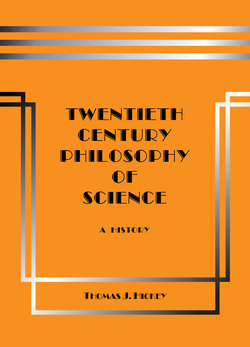Читать книгу Twentieth-Century Philosophy of Science: A History (Third Edition) - Thomas J. Hickey - Страница 96
На сайте Литреса книга снята с продажи.
4.16 Test Logic Illustrated
ОглавлениеConsider the simple case of Gay-Lussac’s law for a fixed amount of gas in an enclosed container as a theory proposed for testing. The container’s volume is constant throughout the experimental test, and therefore is not represented by a variable. The theory is (T'/T)*P = P', where the variable P means gas pressure, the variable T means the gas temperature, and the variables T' and P' are incremented values for T and P in a controlled experimental test, where T' = T ± ΔT, and P' is the predicted outcome that is produced by execution of the test design.
The statement of the theory may be schematized in the hypothetical-conditional form “For every A if A, then C”, where “A” includes (T'/T)*P, and “C” states the calculated prediction value of P', when temperature is incremented by ΔT from T to T'. The theory is universally quantified, and thus claims to be true for every execution of the experimental test. And for proponents of the theory, who are believers in the theory, the semantics of T, P, T' and P' are mutually contributing to the semantics of each other, a fact that could be made explicit in this case, because the equation is monotonic such that each variable can be expressed mathematically as a function of all the others by simple algebraic transformations.
“A” also includes the test-design statements. These statements describe the experimental set up, the procedures for executing the test and initial conditions to be realized for execution of a test. They include description of the equipment used including the container, the heat source, the instrumentation used to measure the magnitudes of heat and pressure, and the units of measurement for the magnitudes involved, namely the pressure units in atmospheres and the temperature units in degrees Kelvin (K). And they describe the procedure for executing the repeatable experiment. This test-design language is also universally quantified and thus also contributes meaning components to the semantics of the variables P, T and T' in “A” for all interested scientists who accept the test design.
The procedure for performing the experiment must be executed as described in the test-design language, in order for the test to be valid. The procedure will include firstly measuring and recording the initial values of T and P. For example let T be 200°K and P be 1.6 atmospheres. Let the incremented measurement value be recorded as ΔT = 200°K, so that the measurement value for T' is made to be 400°K. The description of the execution of the procedure and the recorded magnitudes are expressed in particularly quantified test-design language for this particular test execution. The value of P' is then calculated.
The test outcome consists of measuring and recording the resulting observed incremented value for pressure. Let this outcome be represented by particularly quantified statement O using the same vocabulary as in the test design. Only the universally quantified test-design statements define the semantics of O, so that the test is independent of the theory. In this simple experiment one can simply denote the measured value for pressure by the variable O. The test execution would also likely be repeated to enable estimation of the range of measurement error in T, T', P and O, and the error propagated into P'. A mean average of the measurement values from repeated executions would be calculated for each of these variables. Deviations from the mean are estimates of the amounts of measurement error, and statistical standard deviations could summarize the dispersion of measurement errors about the mean averages.
The mean average of the test-outcome measurements for O is compared to the mean average of the predicted measurements for P' to determine the test outcome. If the values of P' and O are within the estimated ranges of measurement error, i.e., are sufficiently close to 3.2 atmospheres as to be within the measurement errors, then the theory is deemed not to have been falsified. After repetitions with more extreme incremented values with no falsifying outcome, the theory will likely be deemed sufficiently warranted empirically to be called a law, as it is today.
